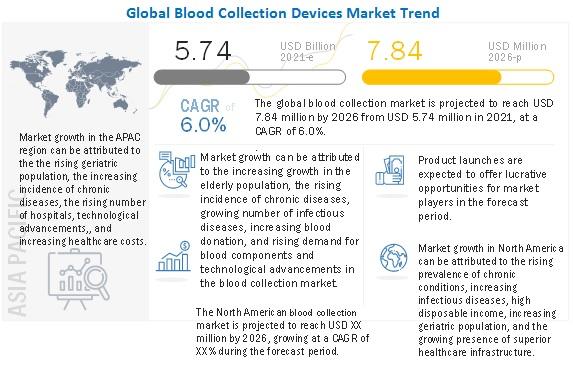The rising prevalence of infectious diseases such as hepatitis B (HBV), hepatitis C (HCV), human immunodeficiency virus (HIV), malaria, syphilis, and brucellosis are a major factor driving the demand for effective blood collection (due to the risk of disease transmission during blood transfusion). According to the WHO (July 2021), there were an estimated 37.7 million [30.2–45.1 million] people living with HIV at the end of 2020, over two-thirds of whom (25.4 million) are in the WHO African Region.
The burden of chronic diseases is rapidly increasing worldwide. Almost half of the total chronic disease deaths are attributable to cardiovascular disease (CVD). In the US alone, as per the American Heart Association, the prevalence of CVD is projected to increase from 36.9% in 2010 to 38.7% by 2020 and 40.5% by 2030.
Download PDF Brochure @ https://www.marketsandmarkets.com/pdfdownloadNew.asp?id=39733117
This scenario has ensured greater adherence to health checkups and the growing importance of markers to find disease conditions mainly via blood collection. Health checkups are gaining popularity both at a personal level as well as performed at a corporate level for employee well-being. This will be favorable for the market growth and a significant contributor to the blood collection devices market, as blood tests are a primary mode of diagnosing these diseases.

The cost of providing apheresis therapy is a matter of almost universal concern. Estimates of costs of individual apheresis treatments are very much available but vary widely. For instance, in the US, the cost of an apheresis procedure is approximately USD 2,500 per treatment. An investment of USD 19,000 to USD 32,000 for a blood cell separator is the initial cost for setting up the machine, and disposable sets produced by manufacturers will vary between USD 40 and USD 90 per treatment.
Storing and shipping whole blood samples poses significant challenges and costs. Once collected, whole blood must be used immediately or stored and maintained under strict temperature and environmental conditions for analysis or other applications. The characteristics of blood samples begin to change within hours of collection if not refrigerated or frozen.
For example, the US FDA recommends that whole blood samples held in specialized containers should only be kept refrigerated for 42 days. However, it is recognized that some changes in the samples may occur during that time.
In 2019, the hospitals, ASCs, & nursing homes segment accounted for the largest share of the blood collection devices market. Growth in this market segment can be attributed to the increasing incidence of infectious diseases and the rise in the number of trauma cases, as well as C-sections and organ transplants.
0
The rising prevalence of infectious diseases such as hepatitis B (HBV), hepatitis C (HCV), human immunodeficiency virus (HIV), malaria, syphilis, and brucellosis are a major factor driving the demand for effective blood collection (due to the risk of disease transmission during blood transfusion). According to the WHO (July 2021), there were an estimated 37.7 million [30.2–45.1 million] people living with HIV at the end of 2020, over two-thirds of whom (25.4 million) are in the WHO African Region.
The burden of chronic diseases is rapidly increasing worldwide. Almost half of the total chronic disease deaths are attributable to cardiovascular disease (CVD). In the US alone, as per the American Heart Association, the prevalence of CVD is projected to increase from 36.9% in 2010 to 38.7% by 2020 and 40.5% by 2030.
Download PDF Brochure @ https://www.marketsandmarkets.com/pdfdownloadNew.asp?id=39733117
This scenario has ensured greater adherence to health checkups and the growing importance of markers to find disease conditions mainly via blood collection. Health checkups are gaining popularity both at a personal level as well as performed at a corporate level for employee well-being. This will be favorable for the market growth and a significant contributor to the blood collection devices market, as blood tests are a primary mode of diagnosing these diseases.

The cost of providing apheresis therapy is a matter of almost universal concern. Estimates of costs of individual apheresis treatments are very much available but vary widely. For instance, in the US, the cost of an apheresis procedure is approximately USD 2,500 per treatment. An investment of USD 19,000 to USD 32,000 for a blood cell separator is the initial cost for setting up the machine, and disposable sets produced by manufacturers will vary between USD 40 and USD 90 per treatment.
Storing and shipping whole blood samples poses significant challenges and costs. Once collected, whole blood must be used immediately or stored and maintained under strict temperature and environmental conditions for analysis or other applications. The characteristics of blood samples begin to change within hours of collection if not refrigerated or frozen.
For example, the US FDA recommends that whole blood samples held in specialized containers should only be kept refrigerated for 42 days. However, it is recognized that some changes in the samples may occur during that time.
In 2019, the hospitals, ASCs, & nursing homes segment accounted for the largest share of the blood collection devices market. Growth in this market segment can be attributed to the increasing incidence of infectious diseases and the rise in the number of trauma cases, as well as C-sections and organ transplants.
